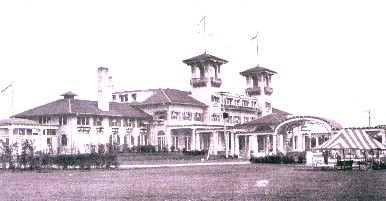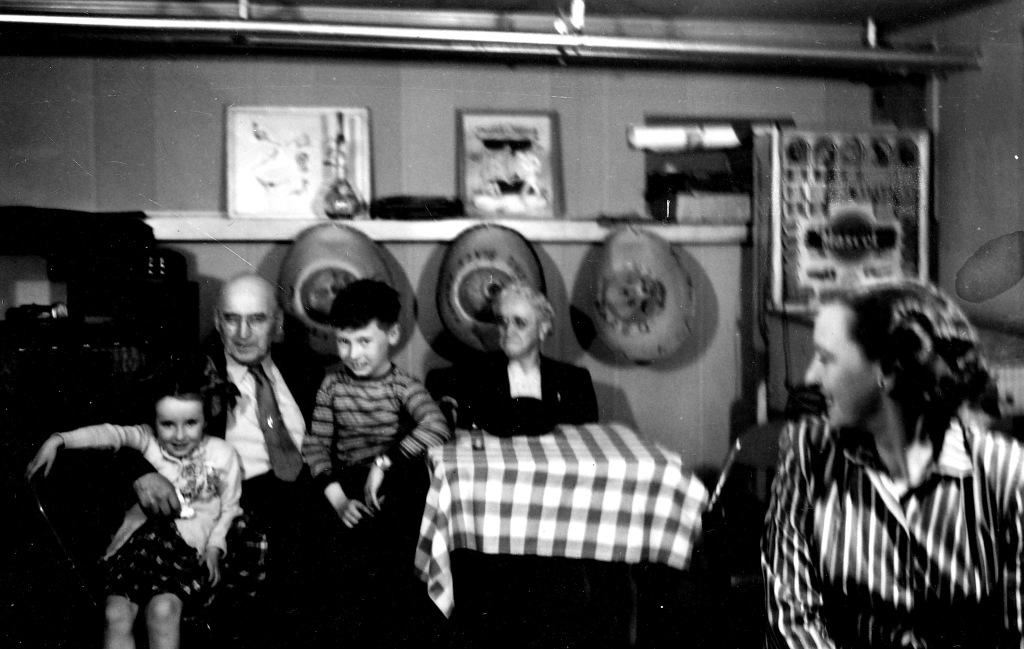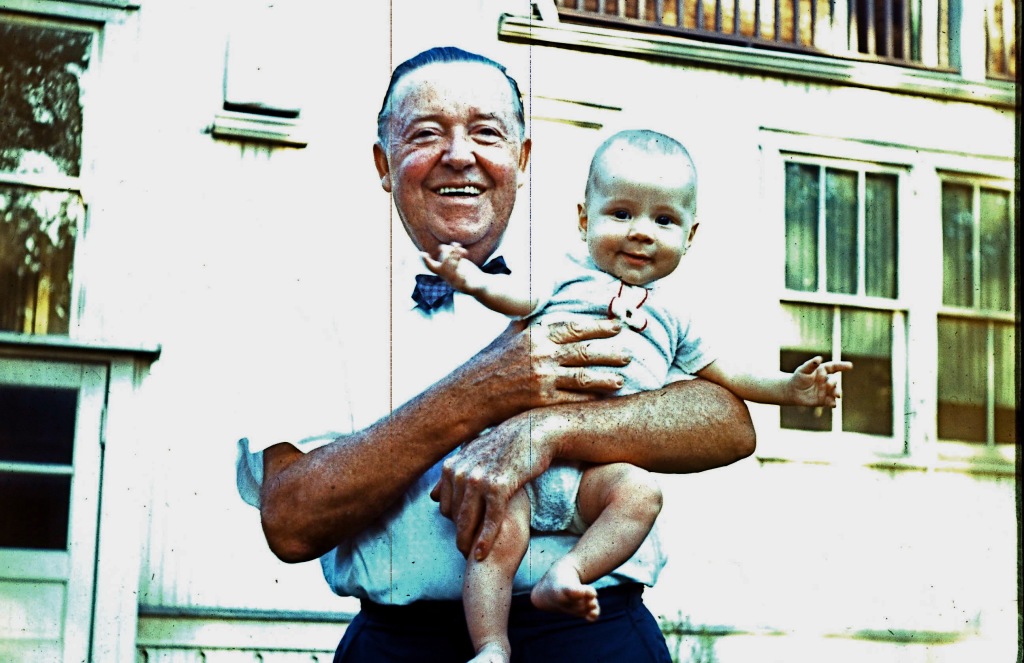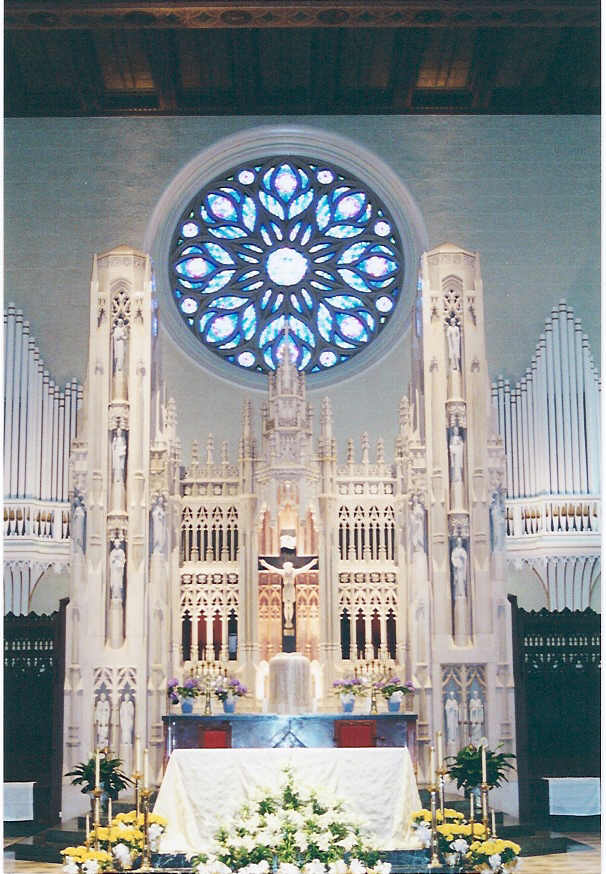I grew up in a Chicago neighborhood called South Shore. At that time, 1943 to 1956, it was one of the nicest parts of the city. Now, now, it is a cesspool of crime.
When my father moved us to the house at 7344 Paxton Avenue, I was 6 years old. The area was quiet and peaceful. Not far away was South Shore Country Club, a beautiful club that offered golf, skeet shooting and a horseback riding to members.
It was a elegant place and I visited a few times but we were not eligible for membership because my father was in the business of owning and repairing juke boxes. That was not a respectable enough occupation. Prosperity was not the criterion. Los Angeles County Club has barred people from the entertainment business for the same reasons.
Our home had been built in 1912 and still had gas lighting fittings in the bathroom and living room, as electrical lighting was still a bit suspect.
This is the house many years after we were gone. It has had the front porch enclosed in brick. Otherwise, it looks much the same. The owner saw me taking a photo and came out to ask me who I was. He insisted on showing me through the house which has had some interior remodeling. He asked if I could send him photos of what it looked like when we lived there but most of my old pictures are home movies.
When I went to school, I began at a Catholic school near our then home on Clyde Avenue. It was the school affiliated with Our Lady of Peace parish.
This is the church that faces 79th street. We moved in 1944 to a new home, the one pictured above.
It was located at 7344 South Paxton Avenue.
The intersection of 74th and Paxton can be clearly seen in the map as well as the proximity of the lake.
The house, itself had a finished basement party room which was actively used when I was small. When the war ended with VJ Day, my parents had a party that lasted three days. When each of the men came home from the war, they would hold a party for him and any of his buddies that came along.
This is an example of one of those parties. There was a wet bar and the back bar had a banner that said “Amiable Al’s Saloon.” There were quite a few marriages that resulted from those parties as my cousin Bud Kerrison had two pretty sisters and they had many pretty girlfriends. My mother stayed in touch with some of those couples for many years.
The fireplace at the right was built by my father and my uncle Art Kerrison. It was too deep because, when they began, they did not realize that the foundation was built as a pyramid with the outer wall sloping out to nearly 6 feet thick at the floor level. I’m sure this was a way of dealing with the soft wet soil. I could dig in the backyard as a child and hit water at about four feet. The entire neighborhood was reclaimed swamp. The result of this discovery was that the fireplace ended up too deep and smoked. In the house photo, the chimney can be seen going up the left side of the house.
In the party photo, my father is standing behind the bar and my uncle Tom, his brother, is standing just by the fireplace with his wife Mavis. My aunt Leona is seen sitting to the right at one of the tables. To the left in the doorway, are standing Paul Jacobson, a friend and Jack Creighton, one of my father’s oldest friends.
Standing next to Paul is Bernice Klingon, the wife of my father’s other best friend, Cliff. Seated in the folding chair is Sid White, who spent part of the war in a German POW camp after his B 17 was shot down. I believe his wife, Ellen is next to him. Behind the bar to the right in the photo is Bud Kerrison (Art Jr) and Pat Neary, one of Marion and Ruth’s friends, who would marry Frank Flanagan after meeting him at one of those parties. The party room was also used for family events, like birthdays. Standing next to my father is Chuck Quinn who lived down the street and had spent the war in the South Pacific with Bud (Victor Jr) Gonya, who would marry my cousin Ruth about four years later. “Bud” was a very common nickname for men who were juniors at that time.
Here is another view of the room, looking toward the back of the house. The bar was in the front. Here are my grandfather and grandmother with my sister Patty and me on their laps. Sitting to the right is a family friend, Blanche Lomas whose husband Chuck was my father’s friend and who enjoyed playing practical jokes on me at times. The jukebox is to the left of the photo and a pin ball machine is to the right. Both were popular with my friends as I grew older. We even had a penny slot machine on the bar for a while. I wish I had it now.
The Mexican straw sombreros were there for years. Looking at the ages of Patty and me, this was probably taken about 1946 when I would be 8 and she would be 5.
The house had a nice big backyard, which is seen here with Jack Creighton holding up my oldest son Mike in 1965, twenty years later. The back of the house shows a “sun porch” that was to the rear of the large living room. Above that is a balcony that opens from a bedroom.
By 1965, the neighborhood was starting to deteriorate and my father was forced to move a couple of year later. It was a shame and I would be interested in owning that house today but not in that area. The present description bears no similarity to what I remember.
The South Shore community has experienced economic decline over the past decade and has not seen much new business growth within its neighborhood. Many new residents from many of the city’s former public housing structures and from further south within the city have resided within South Shore because of its unique location and accessibility to major roadways such as Lake Shore Drive. Crime and gang-related activities continue to plague the community, and safety remains a major concern amongst its residents.
The list of former residents includes Michelle Obama who grew up a half block from my parents’ home but long after we had all left.
The church I attended, St Philip Neri , Would have made a nice cathedral and was the richest parish in the city. The pastor, Monsignor Parker, had been an accountant before he became a priest and he was so successful that the Cardinal, Samuel Stritch, gave him the Illinois #1 license plate for his limousine. We would see him every day. He was elderly by that time but was well known as a business master.
The altar is magnificent and the Christmas display included life sized figures in the creshe. I do contribute to my old elementary school at St Philip Neri School but it is a losing battle, I fear. I did attend the 50th reunion of my 8th grade class in 2002. I am more enthusiastic in contributing to my high school, St Leo Catholic High School, Which seems to be doing well. Their college acceptance rate is higher than it was when I graduated.
One unfortunate consequence of Monsignor Parker’s business success was that St Philip’s loaned money to other parishes and, when the mortgages came due, it lost huge amounts to default by failing parishes. It should have been financially secure, even if the congregation was no longer prosperous. I find it hard to forgive the Church for failing the black community which needs Catholic education whether vouchers are available or not. The public schools are half the problem with the black community in the cities.
In 2002, I attended the 50th reunion of my 8th grade graduation.
A good time was had by all although several were ill and died soon after the reunion.









The South Shore changed from white to black.
We shape our buildings; thereafter they shape us. WSC
It is interesting that your house was built in 1912 but by 1965 the neighborhood was going down hill. It has been my observation that houses have an initial life span of 50 years. By that time they are mechanically obsolete. The original owners are all gone and the character of the neighborhood will have changed as the generations change. At that point the neighborhood goes down hill unless the location or some other factor justifies investment in virtually rebuilding the house to current standards. The lesson is don’t build a house to last more than 50 years. That will become more true as the rate of change continues to accelerate.
Is this true in the rest of the world? Probably a question for Emmanuel Todd, but I don’t recall him dealing much with buildings and their effect on those who find shelter in them. I see pictures of Italian cities and villages on hillsides with houses hundreds of years old still inhabited. Do they modernize their houses? Does the character of their neighborhoods change? Are the houses inhabited by descendants of prior owners, handed down from generation to generation? Or is it the norm that people go off to find their life in another community? Is that the way most people live and the American or Absolute Nuclear Family way of life needs explanation as the exception?
That crime listing is insane. A third world country in and of itself.
“The original owners are all gone and the character of the neighborhood will have changed as the generations change. At that point the neighborhood goes down hill unless the location or some other factor justifies investment in virtually rebuilding the house to current standards.” Houses near us were built in the twenties for university dons. Such people can no longer afford them: it’s lawyers, doctors, businessmen and software people now.
Dearieme,
Those neighborhoods frequently acknowledge their origins by being known as Professorville, however inaccurate today. What’s yours called?
My grandmother lived at 10525 Avenue N in the East Side, five so miles away from the Paxton Avenue address. I spent a good deal of my summers there when I was a kid in the 60s. It was a decent working class neighborhood filled with second or third generation Serbian and Croatian kids and older Polish immigrants. I haven’t been back in decades but Google Maps shows that it hasn’t changed much. The houses are well kept, the streets are clean, and the crime is about one-tenth of the South Shore neighborhood. Looking at the cars on the street it seems like hispanics have moved in, and they lavish as much attention on the appearance of their houses as the Poles before them. The front yards remain neat, tidy, with lots of potted flowers.
I wonder why South Shore changed so much while the East Side seems unchanged, at least according to Google Maps and the crime stats.
Great story.
A little bit after you left the neighborhood was when the South Shore Bank was founded, ostensibly to provide socially responsible loans to the poor souls left behind by white flight. They were supposedly very successful, although that begs the question- if they were such an ideal example of urban financing why did the neighborhood get so much worse as they got bigger and bigger. It was only after they needed to be bailed out for making bad condo loans that the truth came out they were really a taxpayer siphoning operation for political cronies. All the blight should be a reminder of government corruption that perpetuates urban poverty.
Dr. K: Thank you. It is both beautiful and very sad.
From time to time, I go back to the neighborhood where I grew up – well, until I was 10.
Studio City, right on the base of the Hollywood Hills and just down 101 from Universal City.
It is funny – looking back to the late 50s – some things have changed completely and some things the same 50+ years later.
The property has become too valuable to allow widespread crime.
My school, Dixie Canyon, seems the same as when I left in 1959. It was adjacent to a Catholic school and that too seems the same. Many times during recess I would stand by the cyclone fence and talk with my uniformed brethren.
The house, a faux-tudor, that my parents took 6 months to sell for $36,000 – has been extensively remodeled to the point you wouldn’t recognize it. It was built in 1953.
I would imagine with you Dr Kennedy going back to your old neighborhood is a bit more painful, seeing what it has become.
@Mrs D: it’s called West Cambridge.
To add: a house a couple of miles from us is a fine Edwardian villa in a quiet side street, again built for an academic family. It sold recently for £3.25M: that’s about 5 million dollars. Not only is that far too expensive for academic families it’s too expensive for most of the Colleges, three or four of which are close enough to it to have considered buying it as accommodation for a bunch of students.
There’s no point complaining: what was once a remote, somewhat rundown market town with a famous university in it is now a thriving high-tech growth centre with a fast train to London, a motorway to London, and a decent international airport nearby. Stuff happens.
“when the South Shore Bank was founded,”
The bank was there when I was growing up. The name may have changed but there was a great effort to save that neighborhood around the early 1960s. My father finally sold the house for a quarter of what he was offered in 1950 after he was attacked on the front porch one night., He managed to get the door open and the dog attacked the two muggers and drove them off. Before that, kids would walk down the alley and break branches off the cherry trees that grew in the back yard. The “white flight” was strongly encouraged by the lawless element that wanted us all gone. My father sold the house to a white professor who had hopes of gentrification that were probably forlorn. That was 1967.
When I lived there, the neighborhood was mostly Catholic and Jewish. There were several large synagogues nearby that have become black churches. At one time, I was a member of the Young Men’s Jewish Council because the YMCA did not have a basketball court. It was a small matter of pride for us Catholic boys to have Jewish girlfriends. We all went through the stage where they had nose jobs and then black eyes for a week or two. When I was in high school, I dated a girl whose father was a state Senator from that area. He found out we were seeing each other and ended the relationship. He did not want his daughter involved with a non-Jewish boy, although he may have other objections.
Was looking this morning at that photo of the reunion and impressed at how many attended. I was not the only one from out of town. We had a 25th that I attended, as well. That group is made up of two 8th grade classrooms. There were probably more at the reunion than the current school attendance,
The 71st street and 75th street commercial strips are looking like war zones now. I’m going to be in Chicago for a few days to visit in about 3 weeks and I will go by the house. When the (black) owner took me through last time, the main beams that hold up the structure were looking tired. They are wood and about 12 by 12s. They should be replaced by steel but nobody will spend the money in that area. I hope it isn’t sagging,
I guess I never knew the full history of the bank.
Of course, its recent history is is almost too ridiculously byzantine and corrupt to believe, but this is Chicago after all.
Well, I hope your upcoming visit is a good one. Make sure you give us a follow up of how things are going down there.
I’ll take some pics and provide followup for anyone who is interested. My sister lives in Beverly which, when I was a boy, was a very upscale community with several country clubs and big homes. It is sliding now and the refugee Irish (The St Paddy’s Day parade is as big as the downtown one.) may not be able to stay much longer. For those interested in the Chicago Irish summer playground, here is a bit from two years ago. Mayor Daley’s house was about a half mile north of this one. When I was a kid, we had a summer rental there we used every summer. Very Irish.
Mike, you are of a similar age to Georgie Ann Geyer, who also grew up in the South Side of Chicago. Did you ever meet her? Her autobiography, Buying the Night Flight, is well worth the read.
https://en.wikipedia.org/wiki/Georgie_Anne_Geyer
The lesson is don’t build a house to last more than 50 years. That will become more true as the rate of change continues to accelerate.
I beg to differ. I grew up in a house that had parts that were built in the 18th century, the Victorian age complete with gingerbread, and the 1930s. A neighbor bought her parents’ house, which was built in 1715. She recently replaced all the wood siding. Three centuries for siding is a pretty good span.
“Her first job was with the Chicago Southtown Economist.”
Gringo, I delivered the Southtown Economist, About 1953.
I didn’t know her and Calumet High School was south of 87th street and in another area. I had a high school girlfriend who grew up in that area.
She is a recent past president of the Society of Women Engineers. I helped her study math for the SAT. She went to Purdue and I went to California. She lives in California now.
My parents grew up in Hyde Park, about 20 blocks north of South Shore. It too has gone from white to black, but in the last 15 years has started going back to white.
Out here in Denver, the growth of the downtown core area (with the baseball stadium as the first anchor), has spread wealth in all directions, from old brick factories being converted to condos or urbanization as small structures give way to bigger buildings. There are fewer empty lot ‘parking lots’ than at any time in the city’s history.
There’s been a noticeable lag in infrastructure keeping up with the growth. While there will be two markets downtown within the next year or so, there were none before. I also believe the establishment of a strong light rail network with downtown as the hub has helped too, paradoxically (that is, I’d expect less centralization with a good rail hub).
@Overload In CO:
East of Downtown, the Sprouts on Madison & Colfax and the Trader Joe’s on 8th & CO Blvd. has the Bluebird District housing market sizzling, along with Cherry Creek ten blocks south.
Mike–Thanks for this. I went to the U of C Law School in 1970 and there were still a number of profs living in South Shore, but they left by 1980. It says in Wikipedia that South Shore went from 90% white in 1960 to 70% black in 1970, which seems about correct. There are still a lot of middle class black people living in Jackson Park Highlands and Chatham, but the South Loop developments appear to be the mecca for prosperous black professionals. Thanks for the heads up on Leo.